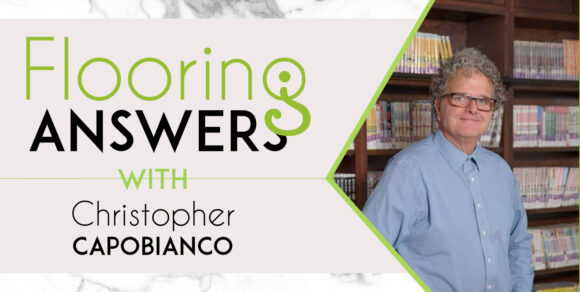Flooring Answers: Eyes on the Tile | A Specifiers Guide to Key Standards for Tile

Tile and stone sold in America comes from all over the world, so having written Key Standards for Tile is important for a good specification. ANSI (American National Standards Institute) and TCNA (Tile Council of North America) are the way we go “by the book” for the tile category, and I’ll be quoting from them here in italics.
Rectangular tile is popular, but design professionals and even installers may not know about standards for tile layout. For example, although often specified, a “Brick” pattern where the end joints are offset 50% is not recommended, 33% is the maximum! For running bond/brick joint patterns utilizing tiles (square or rectangular) where the side being offset is greater than 18”, offset will be a maximum of 33% unless otherwise specified by the tile manufacturer. If an offset greater than 33% is specified, specifier and owner must approve mock-up and lippage [which] refers to differences in elevation between edges of adjacent tile modules.¹ In other words, lippage is when the edge of a tile is higher than the tile next to it so you have a “lip.” Lippage can be caused by tile warpage, substrate conditions or lighting.
Warpage and Lippage
Warpage is a normal result of the manufacturing process when heating and cooling can cause tile to be “domed” slightly higher in the middle. When a 50% offset is used, the highest part of the tile is next to the lowest part of the adjacent one, causing a “lip” at the joint. The 33% offset minimizes this condition.
Substrate defects can also cause lippage, so low spots need to be filled in and high ones ground down before starting the job. A traditional thick mortar bed (often called “mud” although it’s fairly dry), can help the installer compensate for substrate irregularities or tile variation. Add a little “mud” here, take a little away there, and you can create a relatively flat floor. However, most tile installations today are not “mud” but “thin set” mortar, which cannot be used this way, although it is often assumed it can be. While very minor adjustments in height can be made, this method is not appropriate for adjusting the level or flatness of a surface – rather the tile will follow the plane of the substrate.²
Lighting can also be a factor as it can be with so many types of floor coverings. If the light hits the tile a certain way, a small amount of lippage that may be within Key Standards for Tile may look much worse than it is because of shadows.
How much lippage is acceptable?
For tile with grout joints less than ¼”, allowable lippage is 1/32″, plus the inherent tile warpage. This is where the “credit card test” comes from. A single credit card is about 1/32″ thick so they are often used for a lippage “spot check.” I recently saw an installation of a 6″x 24″ “wood look” tile that had some chips at the edges. I measured two credit card thicknesses of lippage, and since it was installed with a 50% offset, it was not covered under warrantee.
How to prevent it?
Wider grout joints can minimize lippage. For running bond/brick joint patterns utilizing tiles with any side greater than 15″, the grout joint shall be, on average, a minimum of 1/8″ wide for rectified tiles, minimum of 3/16″ wide for non-rectified¹. A big challenge in this regard is the trend towards thinner grout joints. Many designers prefer less than 1/8 for a more “seamless” look, but that’s easier said than done sometimes! Rectified tile has a square edge, so lippage is much more of a concern because there is nothing to hide the effect, while a non-rectified tile edge may be rounded, helping to hide a slight lippage. It’s the same in vinyl tile and wood floors, a square edge is much less forgiving than a beveled edge.
As part of an inspection of the tile before installation, “dry lay” a large area of tile to examine the material for quality, set up the layout and prepare for the installation before spreading mortar. Specify at least 5% overage so the installer can “cull” tiles that are out of spec and the client gets some attic stock for any future repairs.
Specifying the right offset, substrate preparation including the type of mortar, site conditions such as lighting, examination of the tile before installation and proper grout joint width are some Key Standards for Tile. All of these factors need to be addressed to prevent lippage and create the flat floor or wall that the client expects. The expertise of the installer has a lot to do with all of these factors, so use experienced tile contractors that are well versed in these variables. The Spartan team has access to a lot of tile specialists in our industry, so don’t be afraid to ask us for help when you need it.
Explore all our Flooring Answer Articles
Explore all our Flooring Answer Videos
ABOUT CHRISTOPHER
Christopher Capobianco covers the NY Metro and Connecticut area for Spartan. He’s a fourth-generation floor coverer whose family has been in the business since the 1930s. For 36 of the last 43 years, he’s had roles in retail, distributor, and manufacturer sales. The other seven years were spent in floor covering training and technical support. He also has been a part time columnist for various flooring magazines since 1988 and is a long-time member of the ASTM Committee on resilient flooring. You can reach him here.